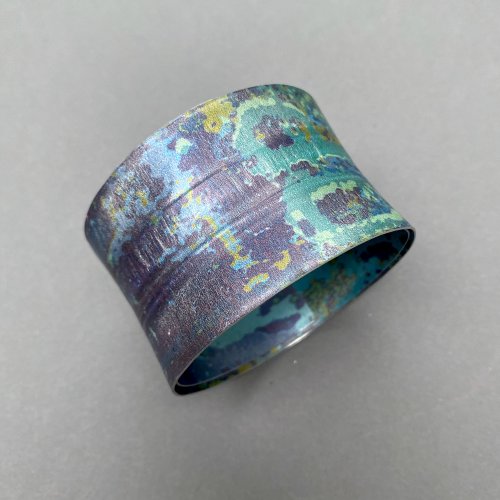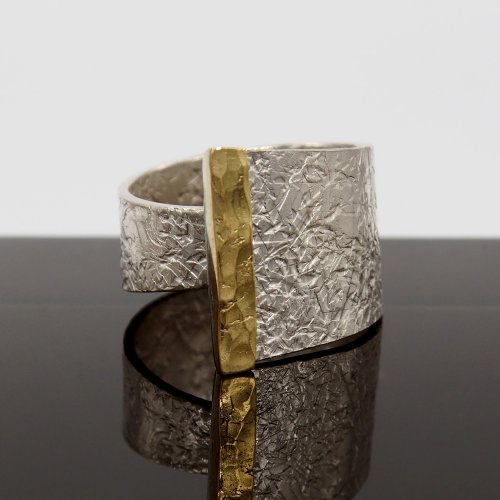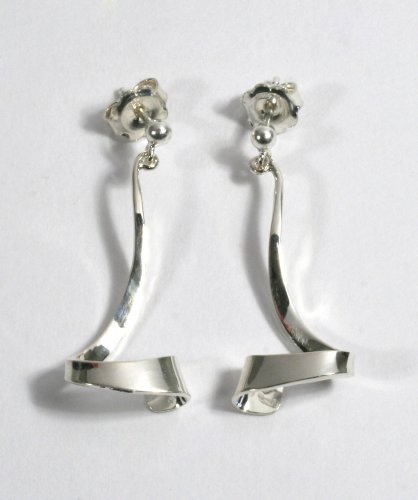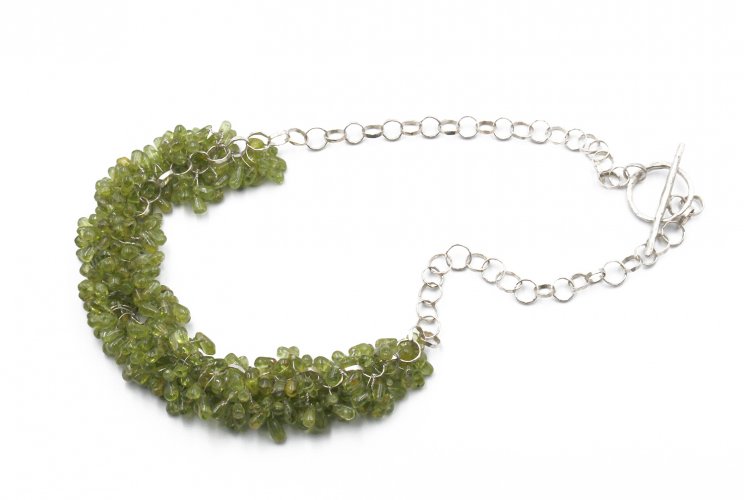Contemporary jewellery is highly innovative with makers using a wide range of precious and non-precious materials.
From traditional gold, silver, and precious stones, through plastics, ceramics and found ephemera, jewellery design today broadens our preconceptions about what we consider to be valuable. Contemporary jewellery celebrates the unique value and desirability of the hand-made and the contribution of the individual artist and designer-maker inspired by a range of influences from fine art, design, craft, fashion and photography.
In this section:
- Anodised Aluminium
Aluminium is anodised by suspending a piece of clean metal in a sulphuric acid and water solution and passing an electric current through it. The surface of the metal combines with oxygen in the solution to create a thin layer of aluminium oxide. This layer cannot flake or peel off, and is resistant to scratching and abrasion. It can however absorb certain dyes and is thus decorated using an array of techniques such block printing, stamping, painting, daubing and transfer printing. Annodised aluminium cannot be soldered so the conventional jeweller's repertoire of assembling a piece cannot be employed. Wires and findings, whether riveted, held in tension or stitched through the aluminium, often become a visible and integral part of the design.
See artists:
- Back to top
- Gold
Au is the chemical symbol for gold and derives from the element's Latin name Aurum. Pure gold known as 24 carat and is a rich yellow colour. Alloys with lower carat, typically 22k, 18k, 14k or 9k, contain higher percentages of copper, silver or other base metals in the alloy. Gold is dense, soft, shiny and the most malleable of the known metals; a single gram can be beaten into a sheet of one square meter.
See artists:
- Back to top
- Mokume Gane
Mokume Gane is a traditional Japanese metalworking technique some three hundred years old. The English translation means woodgrain metal or eye of the wood metal, and refers to the elaborate patterns which can be created with the technique. The process requires the layering of different metals, normally silver, copper and copper alloys. Once soldered together the resulting block of metal is forged and milled into a sheet ready to be pattemed. The pattern can be produced in a variety of ways but all involve breaking through the top layer of metal into the ones below. Once a desired pattern is achieved, the sheet is passed through a rolling mill to produce a smooth patterned sheet of metal ready to be fashioned.
- Back to top
- Pearls
Pearls are classified as either Natural or Cultured and can be further divided into saltwater (gulfs, bays, seas, oceans) and freshwater pearls (rivers, lakes etc.). They are formed when a mollusc secretes layers of nacre around an irritant to protect itself. This irritant can be many things such as tiny snails, particles of seabed debris, shell bits or clay. Natural pearls are rare and very expensive.
Cultured pearls account for over 95% of the world pearl production. With cultured pearls, man has introduced an irritant into an oyster or mussel and then 'cared for it' until the pearl or pearls are ready to be harvested. Saltwater pearls are usually rounder and more expensive than freshwater pearls but the freshwater pearls are cultured in a huge variety of shapes and colours, adding more interest and versatility.- Back to top
- Precious Stones
A Gem is a mineral valuable by virtue of its durability (hardness), rarity, and beauty. Of 120 minerals known to have been used as gemstones, only about 25 are in common use in jewellery today and of these, the Diamond, Emerald, Ruby, and Sapphire are classified as precious, and all the others semi-precious; for example, Topaz, Amethyst, Opal, Citrine and Aquamarine.
Although occasionally used in their rough natural state, most stones are cut. Smooth, dome shaped stones are called Cabochons, and stones which are cut with regularly spaced flat surfaces are called Facets.See artists:
- Back to top
- Silver
Silver is a soft, white, lustrous metal. Jewellery and silverware are traditionally made from sterling silver, an alloy of 92.5% silver with 7.5% copper. Britannia silver is an alternative hallmark-quality standard containing 95.8% silver and is often used to make tableware.
Hallmarks are applied to precious metals by an assay office to verify the content or purity and may be accompanied by a maker's mark or the date of manufacture.- Back to top



